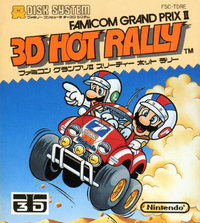From NintendoWiki, your source on Nintendo information. By fans, for fans.
| Famicom Grand Prix II: 3D Hot Rally
|
| ファミコングランプリII 3Dホットラリー
|
|
|
|
|
|
|
|
|
Famicom Grand Prix II: 3D Hot Rally is a racing game for the Famicom Disk System and the successor to Famicom Grand Prix: F1 Race.
It is one of only seven known games which support the Famicom 3D System and the only one published by Nintendo. The Famicom 3D System allows for an early form of stereoscopic 3D.
Development
This game was originally intended to be a regular racing game, however producer Shigeru Miyamoto adjusted the structure of the rallies, made Mario the main character and added the 3D functionality to the game. On the box art, Mario and Luigi can be seen riding the Monster car. This game was Shigeru Miyamoto and Satoru Iwata's first work together.[1][2]
Promotion
Similar to its predecssor, Nintendo held a tournament for the game. This took place From April 14-May 31, 1988. The top 100 players received a gold car trophy with their name and rank on the base, based on their class and encased in quartz crystal, and there were 300 trophies overall. Additionally, runners up and raffle winners recieved a yellow Pretty Mini stationary set themed on Diskun, the mascot for the Famicom Disk System and mock driving licenses.[3][4]
References
